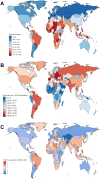Global, regional, and national mortality of larynx cancer from 1990 to 2021: results from the global burden of disease study
- PMID: 40055712
- PMCID: PMC11887237
- DOI: 10.1186/s12957-025-03720-6
Global, regional, and national mortality of larynx cancer from 1990 to 2021: results from the global burden of disease study
Abstract
Background: Larynx cancer, a major upper respiratory tract malignancy, remains a global public health challenge, driven by smoking, alcohol use, and chronic inflammation, despite medical and public health advancements.
Methods: Data from the Global Burden of Disease 2021 study were used to assess larynx cancer mortality trends from 1990 to 2021 across global, regional, and national levels. Death rates, absolute mortality numbers, and Estimated Annual Percentage Change (EAPC) were calculated.
Results: Globally, the number of deaths from larynx cancer increased by 36.67% between 1990 and 2021, while death rates slightly declined, with an EAPC of -0.41. Males consistently accounted for the majority of deaths, with 100,393 deaths in 2021, though female mortality showed a larger percentage increase of 60.13% compared to 33.39% in males. Significant regional disparities were evident, with the highest death rates reported in Eastern Europe and Central Latin America, where countries like Bulgaria and Cuba recorded rates exceeding 6 per 100,000 population. In contrast, Oceania reported the lowest rates, below 0.5 per 100,000. The elderly (75 + years) experienced the largest increase in mortality, rising by 85.4%, while deaths among the 15-49 age group remained relatively stable. Additionally, larynx cancer death rates were correlated with SDI.
Conclusion: Despite slight declines in global death rates, the absolute burden of larynx cancer has increased due to population growth and aging. Regional disparities emphasize the need for targeted interventions and improved healthcare access. This study offers valuable insights for policy and resource planning.
Keywords: Global disparities; Larynx cancer; Mortality trends; Public health.
© 2025. The Author(s).
Conflict of interest statement
Declarations. Ethics approval and consent to participate: Since the study used aggregated and publicly available data, the institutional review board determined that ethics approval and informed consent were not required. The research did not include any human subjects or personal identifying information. Consent for publication: Not applicable. Competing interests: The authors declare no competing interests.
Figures




Similar articles
-
Global, regional and national burden and trends of larynx cancer among adults aged 55 and older from 1990 to 2021: results from the global burden of disease study 2021.BMC Public Health. 2025 Mar 6;25(1):906. doi: 10.1186/s12889-025-21993-0. BMC Public Health. 2025. PMID: 40050798 Free PMC article.
-
Global, regional and national burden and time trends of malaria in children and young adolescents under 15 years from 1990 to 2021: a worldwide observational study.BMC Infect Dis. 2025 Apr 17;25(1):548. doi: 10.1186/s12879-025-10949-9. BMC Infect Dis. 2025. PMID: 40247186 Free PMC article.
-
Global burden of 288 causes of death and life expectancy decomposition in 204 countries and territories and 811 subnational locations, 1990-2021: a systematic analysis for the Global Burden of Disease Study 2021.Lancet. 2024 May 18;403(10440):2100-2132. doi: 10.1016/S0140-6736(24)00367-2. Epub 2024 Apr 3. Lancet. 2024. PMID: 38582094 Free PMC article.
-
Cancer of the Larynx-20-Year Comparative Survival and Mortality Analysis by Age, Sex, Race, Stage, Grade, Cohort Entry Time-Period, Disease Duration and ICD-O-3 Topographic Primary Sites-Codes C32.0-9: A Systematic Review of 43,103 Cases for Diagnosis Years 1975-2017: (NCI SEER*Stat 8.3.9).J Insur Med. 2024 Jul 1;51(2):92-110. doi: 10.17849/insm-51-2-92-110.1. J Insur Med. 2024. PMID: 39266004
-
Global, regional, and national burden of respiratory tract cancers and associated risk factors from 1990 to 2019: a systematic analysis for the Global Burden of Disease Study 2019.Lancet Respir Med. 2021 Sep;9(9):1030-1049. doi: 10.1016/S2213-2600(21)00164-8. Epub 2021 Aug 16. Lancet Respir Med. 2021. PMID: 34411511 Free PMC article.
Cited by
-
Solitary brain metastasis from laryngeal squamous cell carcinoma in a 68-year-old male: A Case Report.Ann Med Surg (Lond). 2025 Jul 18;87(8):5296-5299. doi: 10.1097/MS9.0000000000003549. eCollection 2025 Aug. Ann Med Surg (Lond). 2025. PMID: 40787541 Free PMC article.
References
MeSH terms
LinkOut - more resources
Full Text Sources

